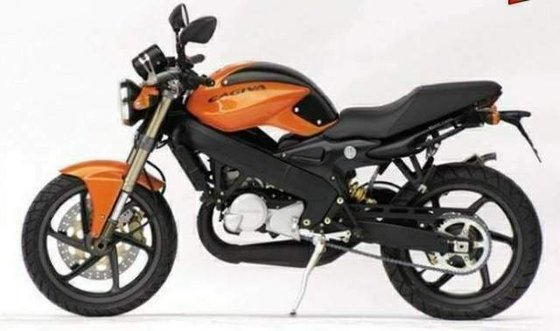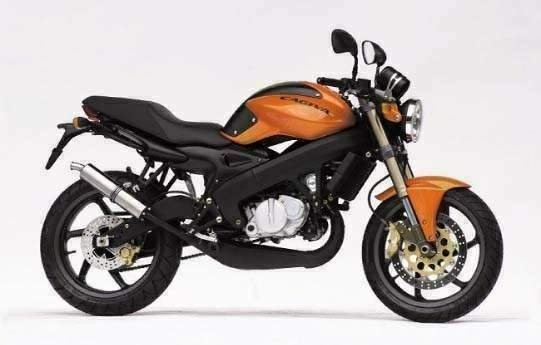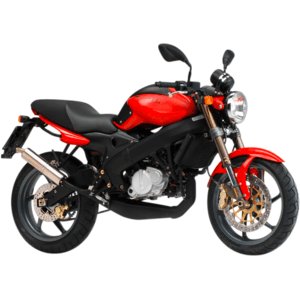Cagiva Raptor 125 (2003-2012): A Two-Stroke Streetfighter for the Rebellious Soul

Introduction
The Cagiva Raptor 125 isn’t just a motorcycle—it’s a declaration of independence. Produced from 2003 to 2012, this Italian-made naked bike defied the mundane expectations of 125cc commuters with its snarling two-stroke engine, razor-sharp styling, and a chassis that borrowed DNA from bigger, angrier machines. Designed for riders who wanted to stand out in a sea of bland beginner bikes, the Raptor 125 remains a cult favorite for those who crave character over conformity. Let’s dissect why this little predator still claws its way into riders’ hearts.
Design & Aesthetics: Small Bike, Big Attitude
The Raptor 125’s design is a masterclass in illusion. At first glance, its muscular tank, twin-headlight aggressive stance, and chunky 150/60-ZR17 rear tire suggest a liter-bike’s menace shrunken to 125cc proportions. The aluminum "Profi" frame, finished in bold red or stealthy black, gives it a premium look, while the upside-down Marzocchi forks and Sachs rear shock hint at serious hardware.

Key Design Highlights:
- Compact but Commanding: With a wheelbase of 1,374 mm (54.1 inches) and a seat height ranging from 775–800 mm (30.5–31.5 inches), it’s approachable for shorter riders but still assertive.
- Naked Aggression: The minimal bodywork exposes the engine and frame, emphasizing its mechanical rawness.
- Tire Drama: The 150mm-wide rear tire—unusual for a 125cc bike—adds visual heft and stability.
Engine & Performance: The Two-Stroke Scream
At its heart lies a liquid-cooled, single-cylinder two-stroke engine displacing 124.6cc. With a bore x stroke of 56 x 50.6 mm (2.2 x 2.0 inches) and a 13:1 compression ratio, this mill delivers 11–15 HP (depending on model year) at a shrieking 9,100 RPM. Torque peaks at 12–14 Nm (8.9–10.3 lb-ft), but the real magic is in the powerband—a narrow, frenetic window that demands commitment.
Riding the Powerband:
- Controlled Chaos: Below 7,000 RPM, the Raptor feels docile. But cross that threshold, and the two-stroke wakes up with a violent surge, pulling hard until redline. It’s addictive but requires constant gear-shuffling (thank the precise 6-speed gearbox).
- Soundtrack: The exhaust note is a raspy, high-pitched wail—a dying breed in today’s muted four-stroke world.
- Top Speed: 120 km/h (75 mph) is achievable, though sustained highway riding drains the 12.5L (3.3-gallon) tank quickly.
Two-Stroke Quirks:
- Premix Rituals: No oil injection here—fuel up with a 2% oil mix, or risk seizing the engine.
- Heat Management: The liquid cooling system (1.3L capacity) keeps temps in check, even during spirited rides.
Riding Experience: Lightweight Flickability
Weighing just 125 kg (275.6 lbs) dry, the Raptor 125 feels like a bicycle with a jet engine. The upright riding position and wide bars make it a hooligan in city traffic, while the suspension soaks up bumps with surprising composure.
Handling Breakdown:
- Front End: The 40mm Marzocchi USD forks offer 120 mm (4.7 inches) of travel—stiff enough for aggressive cornering but compliant over potholes.
- Rear Suspension: The Sachs shock’s 140 mm (5.5 inches) of travel keeps the rear planted during hard acceleration.
- Brakes: Single 320mm front and 220mm rear discs (Brembo on later models) provide adequate stopping power, though ABS is absent.
Tires & Grip:
The 110/70-ZR17 front and 150/60-ZR17 rear tires offer tenacious grip, encouraging knee-down antics on twisty roads. Just keep tire pressures at 1.9 bar (27.5 psi) front and 2.0 bar (29 psi) rear for optimal performance.
Competition: How the Raptor Stacks Up
The Raptor 125 faced fierce rivals in the 125cc segment. Here’s how it compares:
1. Yamaha YZF-R125 (2008–)
- Engine: Four-stroke, 124.7cc, 15 HP.
- Pros: Fuel injection, smoother power delivery, modern tech.
- Cons: Heavier (129 kg), less character.
- Verdict: The Yamaha is the sensible choice; the Raptor is the rebel.
2. Aprilia RS125 (1992–2012)
- Engine: Two-stroke, 124.8cc, 30 HP (race-derived).
- Pros: Faster, sharper track focus.
- Cons: High maintenance, intimidating for beginners.
- Verdict: The Aprilia is a race bike in disguise; the Raptor is street-first.
3. KTM 125 Duke (2011–)
- Engine: Four-stroke, 124.7cc, 15 HP.
- Pros: Agile chassis, upright ergonomics.
- Cons: Less visceral than the Raptor’s two-stroke.
- Verdict: The Duke is a better all-rounder, but lacks the Raptor’s raw edge.
Why the Raptor Stands Out:
Its two-stroke engine and naked-bike aggression make it unique in a segment dominated by tamer four-strokes. It’s a bike that rewards skill and thrives on adrenaline.
Maintenance: Keeping the Beast Alive
Two-strokes demand diligence, but the Raptor 125 is relatively simple to maintain. Here’s what owners need to watch:
1. Engine Care
- Premix Fuel: Use 98-octane fuel with a 2% two-stroke oil mix.
- Spark Plugs: NGK BR9EG (standard) or BR9EIX (iridium). Check gap at 0.5 mm.
- Coolant: Replace every 2 years with ethylene glycol-based coolant (1.3L capacity).
2. Transmission & Drivetrain
- Gearbox Oil: 800 ml of SAE 5W-40, changed annually.
- Chain: Clean and lubricate regularly. The 14/43 sprocket ratio wears quickly under hard riding—inspect for stretch.
3. Suspension & Brakes
- Fork Oil: 425 ml per leg of SAE 7.5W oil.
- Brake Fluid: Flush with DOT 4 fluid yearly.
MOTOPARTS.store Upgrade Recommendations:
- Performance Exhaust: Unlock a sharper throttle response and louder bark.
- Upgraded Sprockets: Durable aftermarket sprockets reduce wear from the aggressive power delivery.
- Ergo Tweaks: Lowered footpegs or a gel seat improve comfort for longer rides.
Conclusion: A Bike That Teaches Passion
The Cagiva Raptor 125 isn’t about numbers—it’s about feeling alive. Its two-stroke engine, flickable chassis, and head-turning design create an experience that modern four-strokes can’t replicate. Yes, it’s fussy. Yes, it demands your attention. But for riders willing to embrace its quirks, the Raptor 125 delivers a raw, unfiltered connection to motorcycling’s rebellious spirit.
Whether you’re hunting for replacement parts or performance upgrades, MOTOPARTS.store has everything to keep your Raptor roaring. Because legends deserve to stay on the road.
Specifications sheet
| Engine | |
|---|---|
| Stroke: | Two-stroke |
| Max power: | 11 kW | 15.0 hp |
| Max torque: | 14 Nm |
| Fuel system: | Dell’Orto VHST 28 carburetor (premix) |
| Lubrication: | 2-stroke premix |
| Max power @: | 9000 rpm |
| Displacement: | 125 ccm |
| Max torque @: | 8250 rpm |
| Configuration: | Single |
| Cooling system: | Liquid |
| Compression ratio: | 7.4:1 |
| Number of cylinders: | 1 |
| Dimensions | |
|---|---|
| Wheelbase: | 1374 mm (54.1 in) |
| Dry weight: | 125 |
| Seat height: | 800 mm (31.5 in) |
| Ground clearance: | 175 mm (6.9 in) |
| Fuel tank capacity: | 12.5 L (3.3 US gal) |
| Drivetrain | |
|---|---|
| Final drive: | chain |
| Chain length: | 118 |
| Transmission: | 6-speed |
| Rear sprocket: | 43 |
| Front sprocket: | 14 |
| Maintainance | |
|---|---|
| Rear tire: | 150/60-z-17 |
| Front tire: | 110/70-z-17 |
| Brake fluid: | DOT 4 |
| Gearbox oil: | SAE 5W-40 |
| Spark plugs: | NGK BR9EG or NGK BR9EIX |
| Premix ratio: | 2% (50:1) with 2-stroke oil |
| Forks oil type: | SAE 7.5W |
| Spark plug gap: | 0.5 |
| Coolant capacity: | 1.3 |
| Forks oil capacity: | 0.85 |
| Oil change interval: | Every 5000 km or annually |
| Gearbox oil capacity: | 0.8 |
| Recommended tire pressure (rear): | 2.2 bar (32 psi) |
| Recommended tire pressure (front): | 2.0 bar (29 psi) |
| Chassis and Suspension | |
|---|---|
| Frame: | Aluminium Profi frame |
| Rear brakes: | Single 220 mm disc, 1-piston caliper |
| Front brakes: | Single 230 mm disc, 2-piston caliper |
| Rear suspension: | Sachs progressive monoshock with hydraulic adjustment |
| Front suspension: | Marzocchi upside-down telescopic fork (USD), 40 mm diameter |
| Rear wheel travel: | 140 mm (5.5 in) |
| Front wheel travel: | 120 mm (4.7 in) |


















